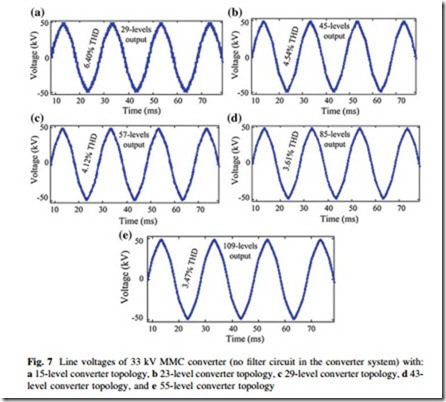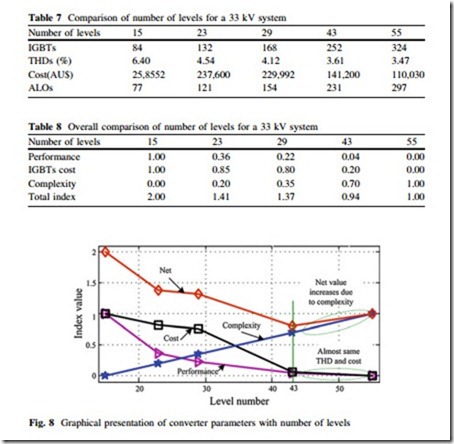Selection of Number of Converter Levels
The component number and control complexity increase linearly with the increase of level number. Therefore, optimal selection of number of converter level is important for the best performance/cost ratio of the converter system. Each H- bridge inverter cell commutation voltage of a 15-level topology-based 33 kV inverter is 3,467 V, which may be supported by the 6.5 kV IGBT. Thus, at least 15-level topology is required to design a 33 kV converter. The output power quality of 55-level inverter is good enough to feed into the 33 kV ac grid directly. The cheap 1.7 kV IGBT can be used to design 55-level converter. Therefore, 15- level to 55-level MMC topologies can be considered for a 33 kV converter system.
The device voltage utilization factor (DVUF); ratio of commutation voltage of respective commutation cells (Vcom) and (Vcom@100FIT), are counted in the design process. Higher DVUF is essential for cost-effective design, since semiconductor cost is the significant figure in medium voltage converter applications. In order to ensure cost-effective design, the converters with level numbers of 15, 23, 29, 43, and 55 for a 33 kV converter were considered for the further analysis. These converter systems have been designed and analyzed in the MATLAB/Simulink environment. Figure 7 shows the simulated output voltage waveforms of 15, 23, 29, 43, and 55 level MMC converters. The number of ALOs for switching section and cost of semiconductors are calculated. The number of ALOs is used to compare the complexity of the converters.
The THDs are calculated through the MATLAB/Simulink environment. Table 7 summarizes the calculated data for a 33 kV converter with different number of levels. The component number and control complexity increase linearly
with the increase of level number. Moreover, there is no significant output power quality improvement and semiconductor cost reduction for converters with more than 43-level systems. Therefore, the 43-level MMC converter may be considered for a 33 kV converter system. The output power quality of 43-level converter system is good enough to feed the converter output into the medium voltage grid directly (i.e., no step-up transformer or line filter circuit is required). Equation (1) is used to calculate the normalized values of the three significant parameters: performance, complexity, and cost of the converters. Table 8 summarizes the index values of Table 7. Based on the index values, overall performance graphs are plotted and shown in Fig. 8, showing that the total index value is the lowest for 43-level converter, which is the optimal level number for 33 kV systems.


